In a decisive game that could save Rangers’ season, Celtic surpassed their eternal rival by winning 0-1 in the Old Firm derby.
Celtic, the current leader of the Scottish Premiership, reached the final of the Scottish Cup on Sunday, having the possibility of winning this trophy three seasons after their last.
It was a very aggressive game with 23 fouls in total and was decided in some small details. The Portuguese Jota was decisive again after scoring the only goal of the match with a fine header.
In this tactical analysis, we’ll try to cover and unveil the main tactical causes that resulted in Celtic’s dominance, especially in the first half, to win in this derby. There will be also room to do an analysis regarding the shift in Rangers’ tactics in the second period of the game.
Lineups
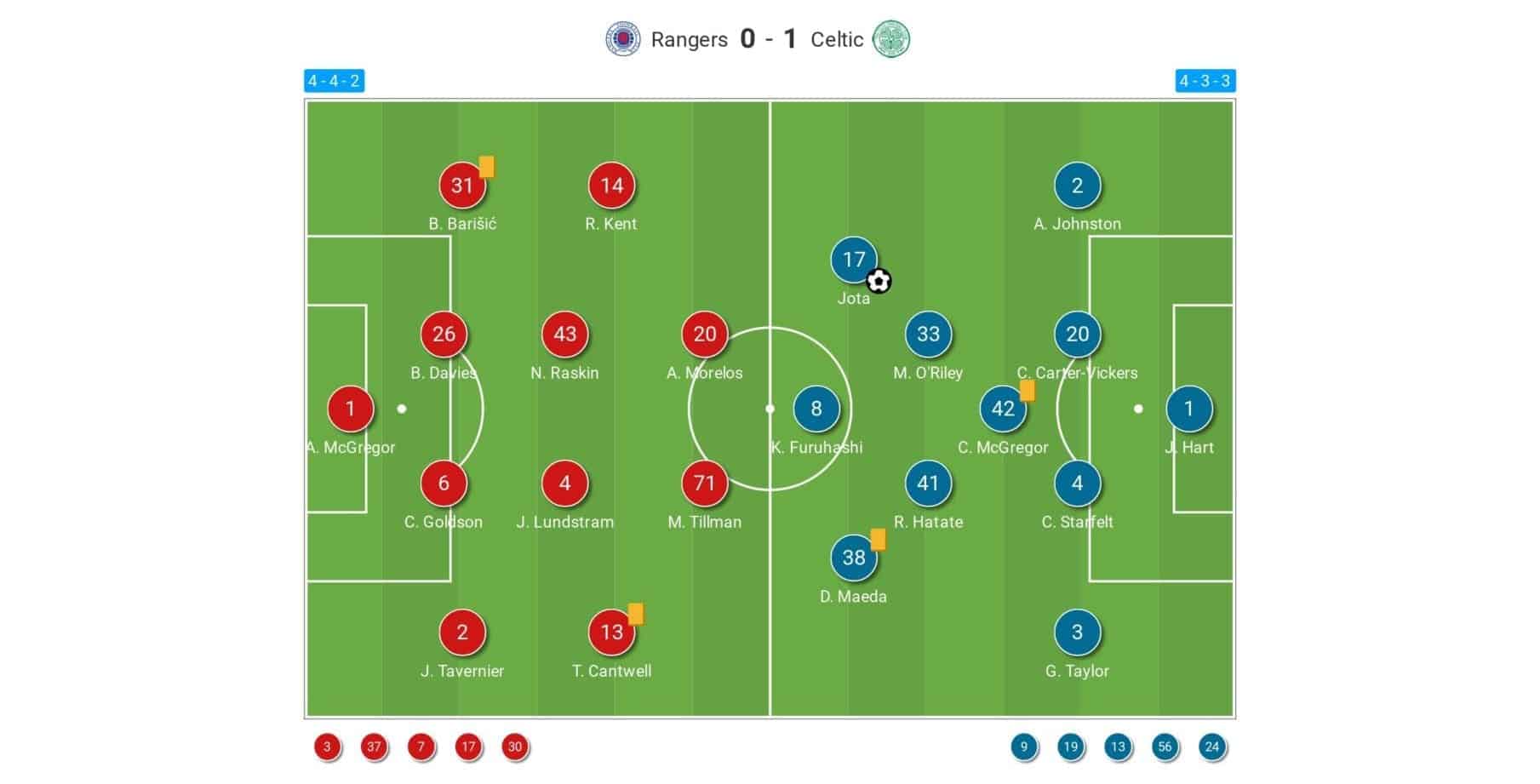
Michael Beale’s side on defensive organization was composed in a 4-4-2, where the two main attackers were Alfredo Morelos and Malik Tillman. However, in possession, Ryan Kent joined the two attackers, switching to a 4-3-3.
Nicolas Raskin and John Lundstram were the defensive midfielders and Todd Cantwell played just ahead of them.
As for the defensive line, it was formed by the veteran Allan McGregor in goal, by the two centre-backs, Connor Goldson and Ben Davies, and by Borna Barisic and James Tavernier as fullbacks.
Concerning Celtic’s formation, it was organised in a 4-3-3, with Jota and Daizen Maeda as wingers and Kyogo Furuhashi as the most advanced element of the team.
Reo Hatate and Matt O’Riley performed as midfielders exploring spaces between the lines, while Callum McGregor played further back in build-up.
Joe Hart started in goal, while Greg Taylor, Carl Starfelt, Carter-Vickers and Alistair Johnston together composed the initial defensive line.
Celtic’s decisive and dominant in the first half
Ange Postecoglou’s pressing plan and build-up strategy were fundamental to succeed against their greatest rival, Rangers.
Let’s start with Celtic’s pressing plan, where they opted for an intense high block and where the offensive midfielder (Hatate) joined Kyogo in marking the other centre-back. Both of the wingers pressed the two Rangers fullbacks whenever they carried the ball.
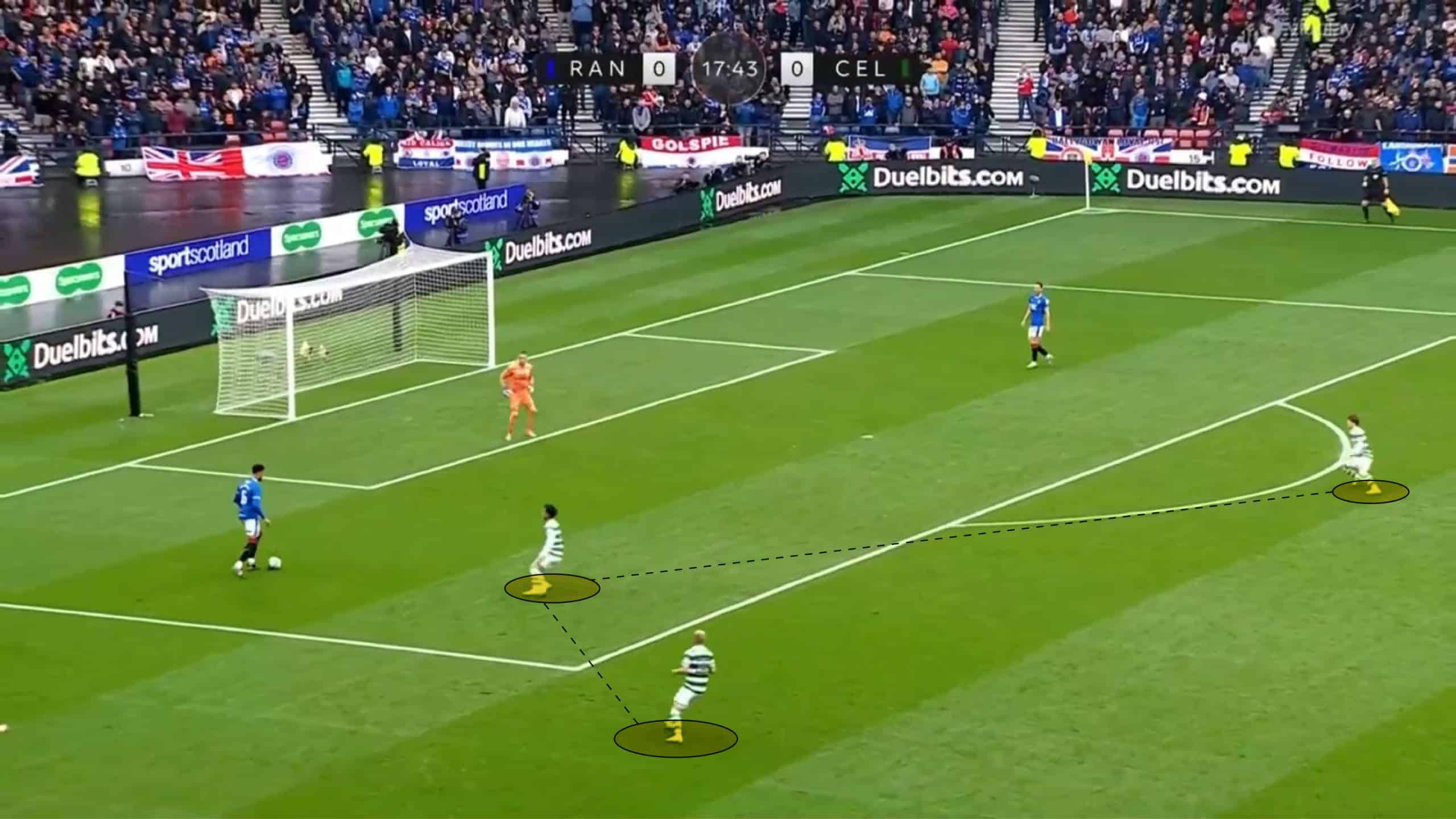
Although Hatate’s high pressing helps to condition the opposition’s build-up, it also has its risks. In this case, Rangers had numerical superiority in the midfield area with three Rangers players against two Celtic midfielders, as we can see in the image below.
As a matter of fact, in the first half, this inferiority had a small impact on Celtic’s defensive organisation due to some adjustments, as we’ll discuss further.
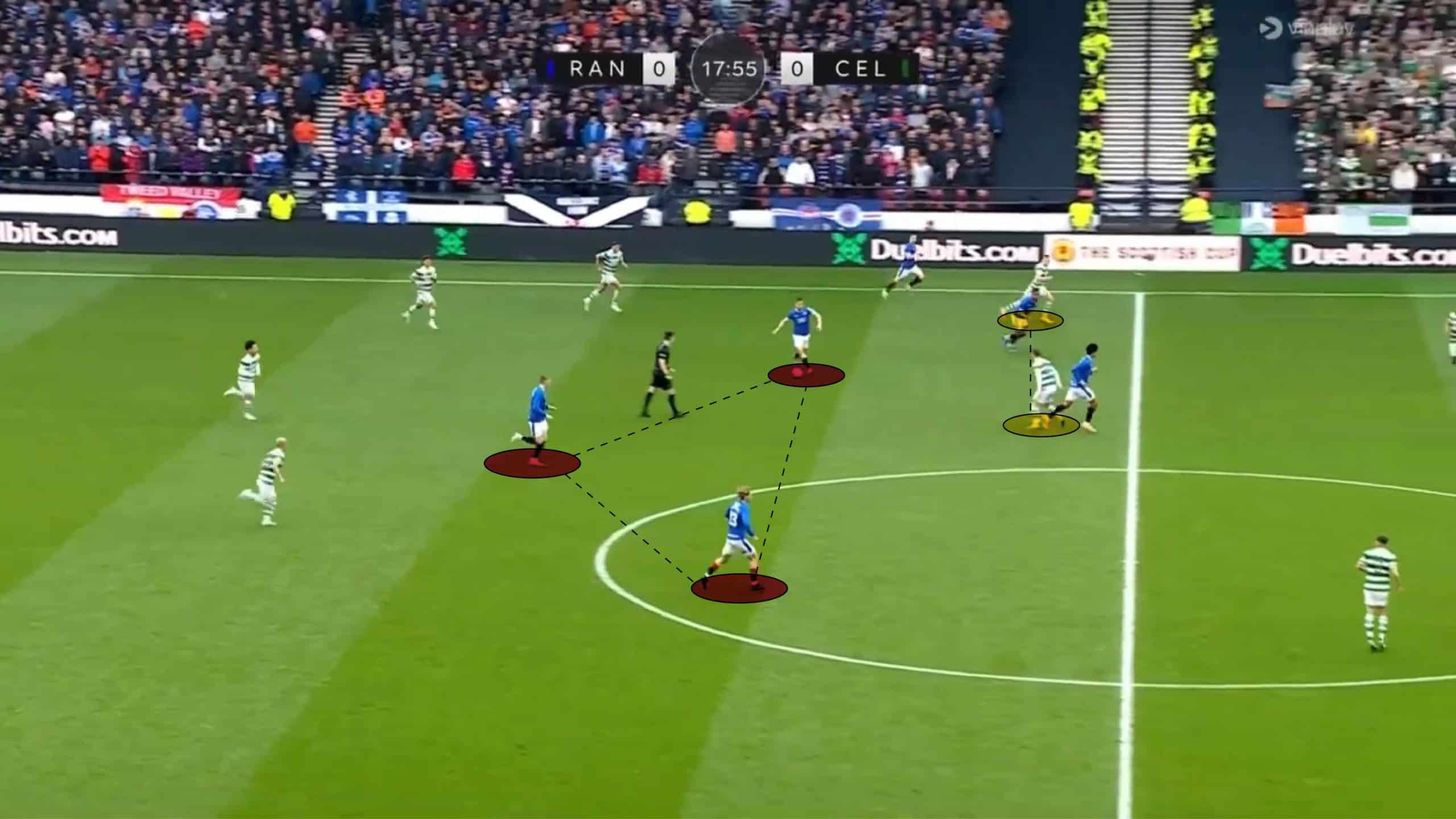
Yet, both wingers and Reo Hatate were able to overcome this problem by always being alert and scanning for what was happening behind them. It required concentration and a high level of tactical knowledge to identify and solve those kinds of situations during the game.
In our first example of Celtic’s tactical adjustment, we can see that Jota is positioned inside before pressing Barasic, in order to compensate for such numerical inferiority in the midfield. Only after the pass is made by the centre-back does Jota immediately press Barisic.
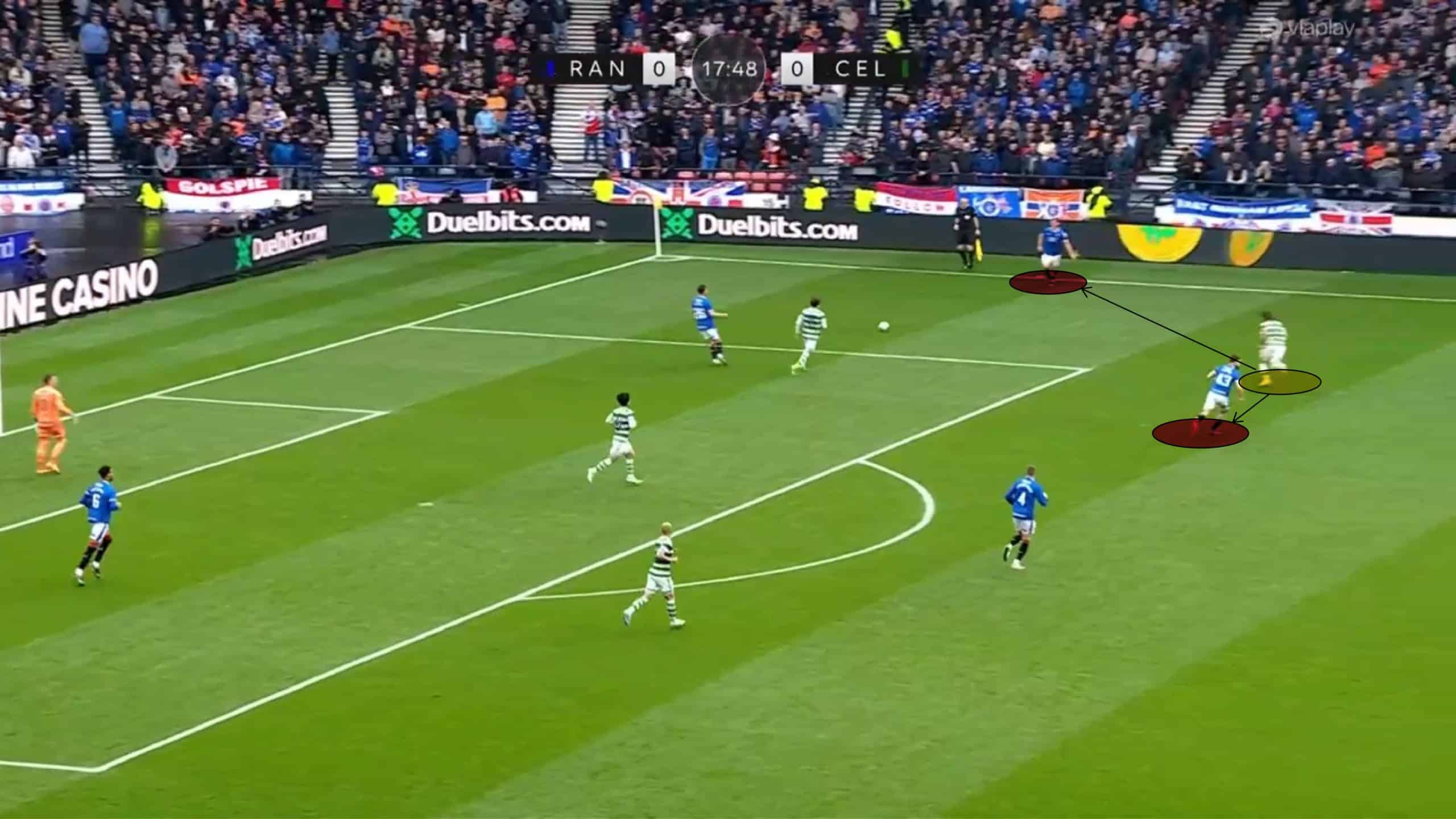
Another detail that we found interesting is related to Hatate’s positioning. When Kyogo pressed the ball carrier, Hatate descended slightly on the pitch and positioned himself inside, covering up a possible defence-to-midfield connection.

Besides that, in such cases where Rangers’ build-up was successful, the offensive players showed great team spirit by helping their teammates in the defensive process. Against a team that feels comfortable playing in transitions like the Rangers, it is very important to have this kind of commitment and defensive cohesion.
In the image below, we can see Maeda recovering the ball after an excellent effort in the defensive transition.
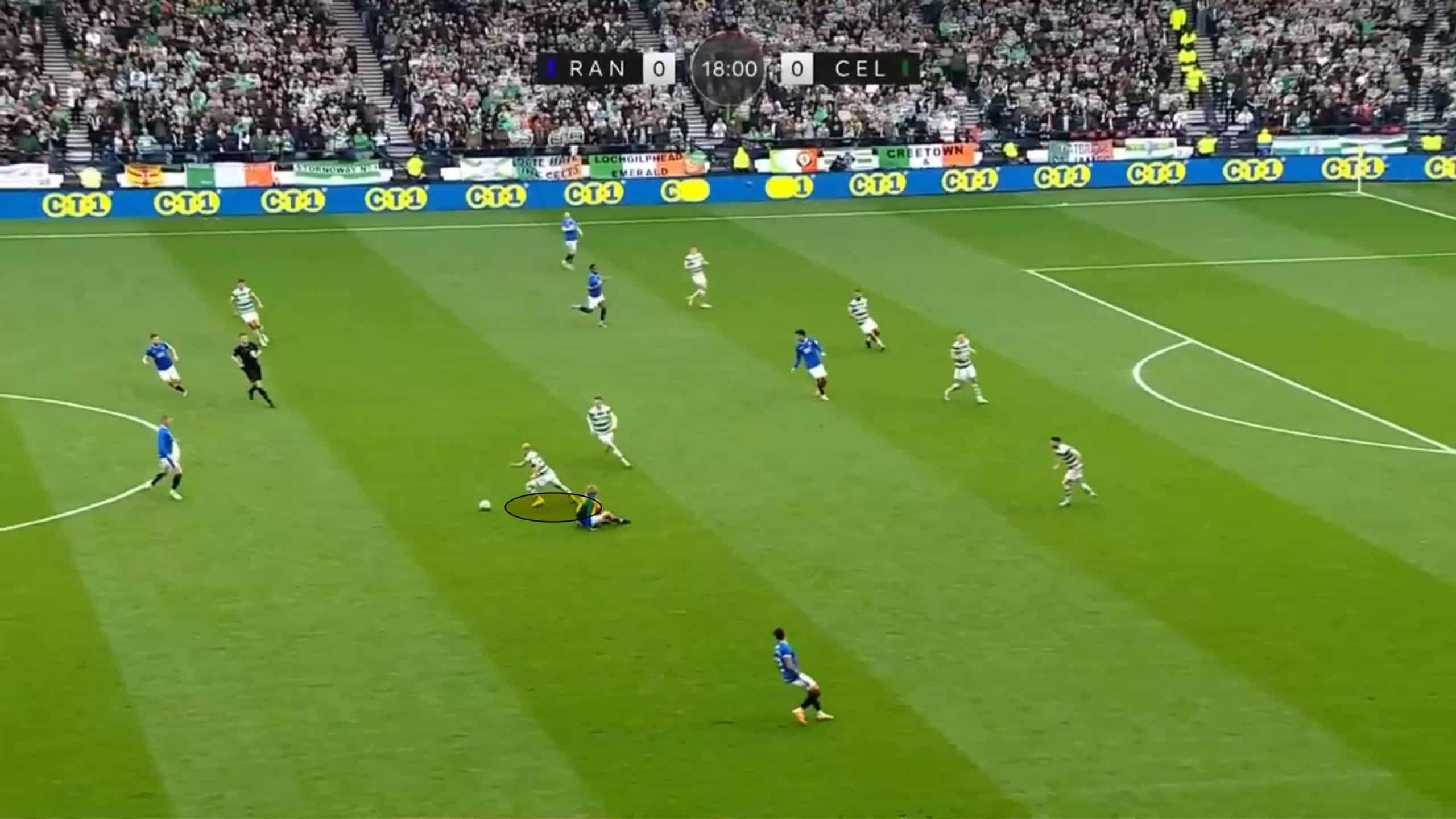
In the first half, Celtic were able to obstruct Rangers’ build-up, forcing them to play a more direct game, especially by the left flank where Barisic is technically less developed than Tavernier.
In a physical disadvantage compared to the opposition defenders, the Rangers strikers’ lost most of the duels, and the Celtic formation was able to re-establish their dominance in the organisation.
Concerning Celtic’s build-up, it has some similarities with Borussia Dortmund not only because, preferentially, they are organised in a 2-3-2-3, but also because they use their left back as an inverted fullback.
In addition, they were a very flexible team regarding positioning and were capable of misguiding Rangers’ pressing plan during their offensive organisation.
In fact, Greg Taylor’ is a very mobile player, having explored both interior and exterior spaces during the game. Whenever Taylor was inside, the left flank was immediately occupied by the offensive midfielder Hatate or by the left winger Maeda. Playing with inverted fullbacks also helped Celtic to stop Rangers’ counterattacks more effectively.

Other evidence that mobility promoted a successful build-up can be exemplified by Kyogo’s positioning.
In the image below, we can see Kyogo dropping down and exploring the space between the lines together with O’Riley. It is important to mention that Rangers preferred a man-marking rather than a zonal approach.
With that said, Raskin gets divided and the centre-back leaves the back line, marking the other players between the lines. Just like that, Celtic’s mobility created disorganisation in Ranger’s defensive line and more space to create dangerous opportunities.
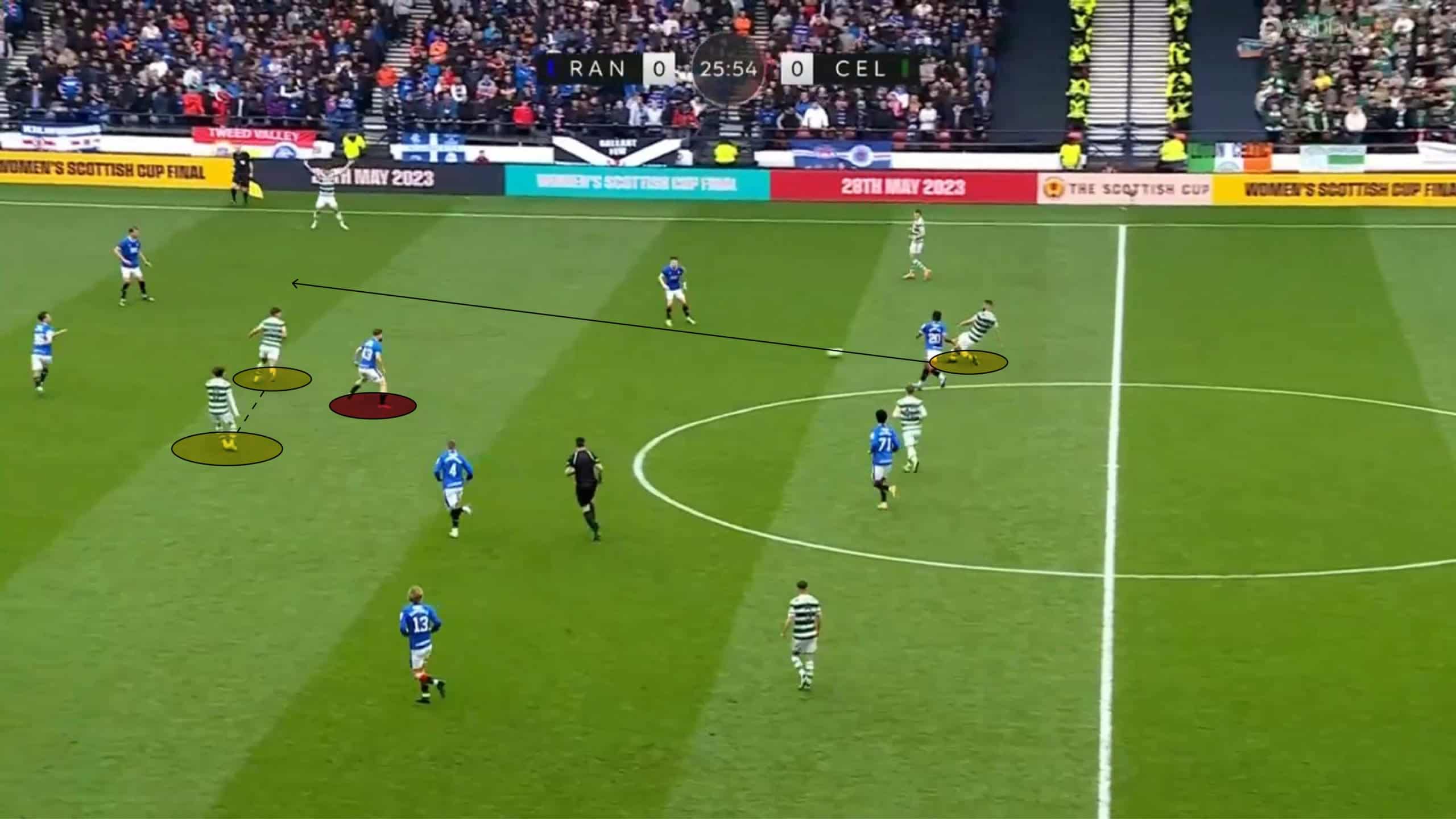
Rangers’ second-half improvement
Due to some tactical changes by both sides, the second half was much more balanced and if Rangers were more effective in the final third, they could have at least equalised the match.
Thanks to, in great part, their physical exhaustion, Celtic decreased their pressing intensity and Rangers were able to build up more successfully. In fact, the final possession was 52% to 48% in favour of Rangers. Besides that, Celtic’s defensive transitions were also worse in comparison with the first half.
In the image below, we can see the numerical superiority in the midfield zone that we previously mentioned, when neither the offensive midfielder nor one of the wingers dropped down to support defensively.
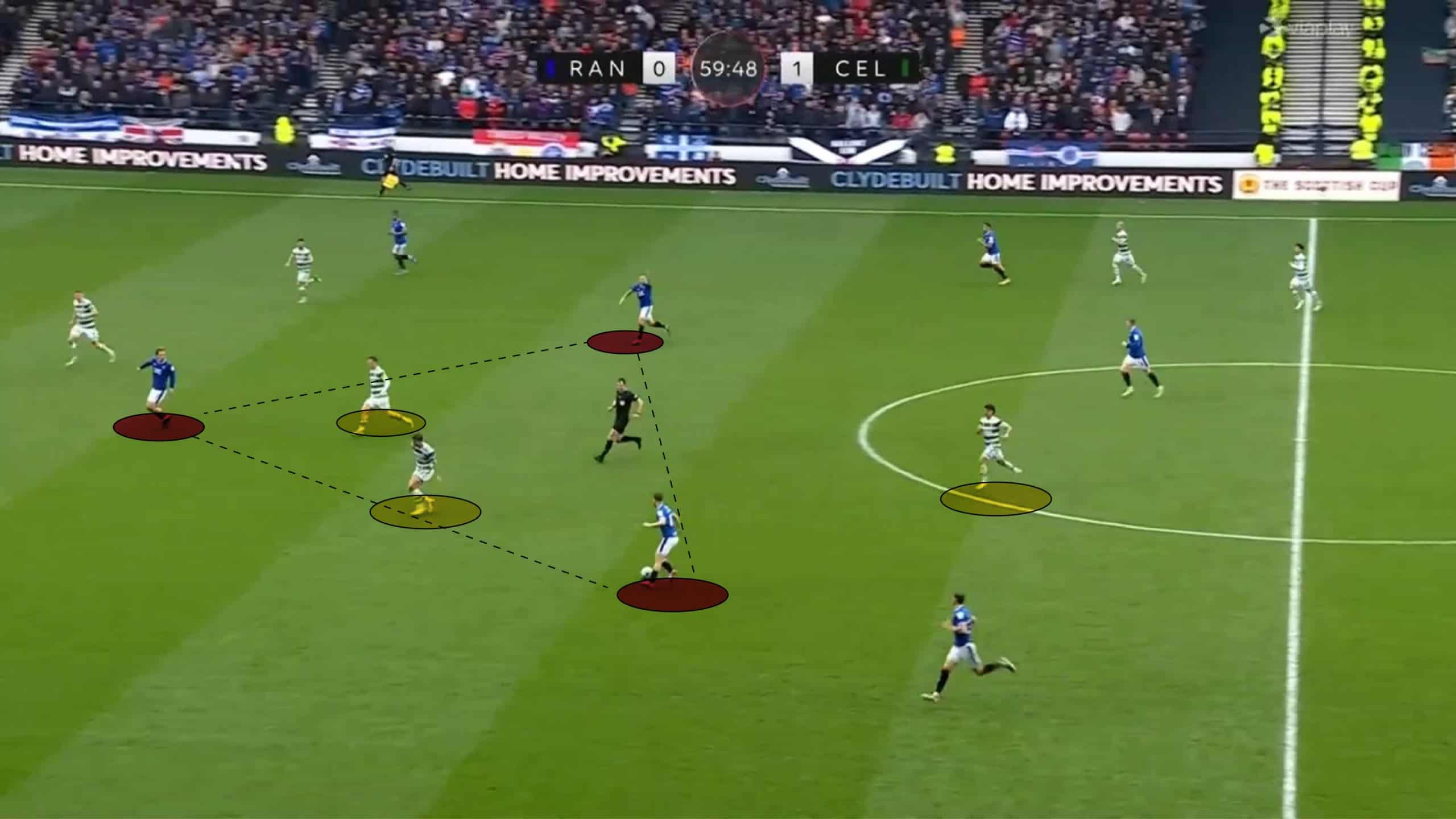
As a result of a more successful build-up, Tavernier started to position himself deeper on the field and Barisic was also more advanced, with less offensive involvement.
The Rangers right back was again fundamental and crucial to the offensive process of his team, with fine crosses and with strong and quality shots outside of the box. Currently, he is the defender with the most goal contributions in all the top-flight leagues worldwide with 21 contributions in 31 games.
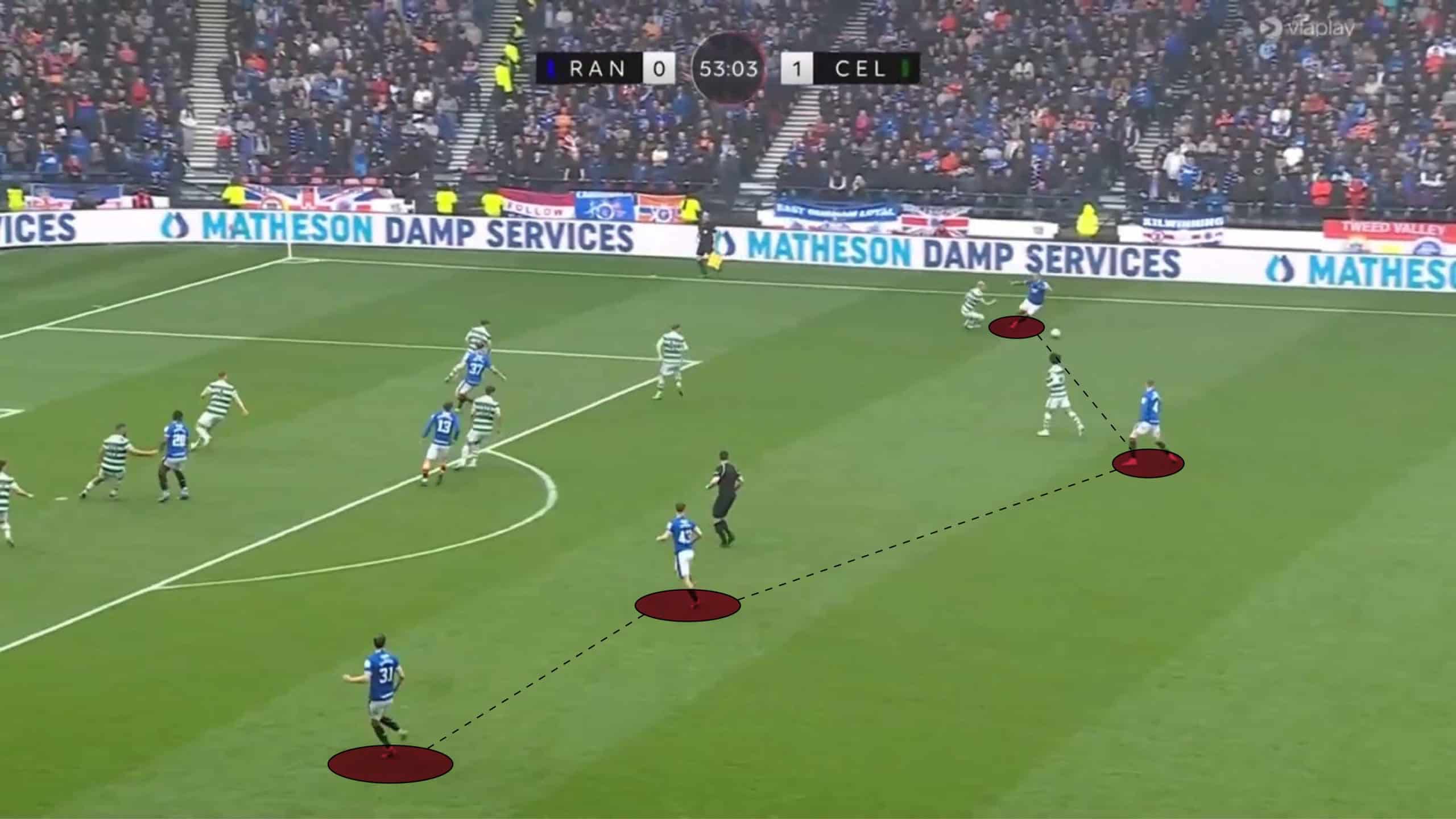
Michael Beale also instructed his team to push their block higher and press with more intensity. By trying to block Celtic’s build-up, Rangers had far more possibilities to win duels on the midfield and consequently to create more chances during the game.
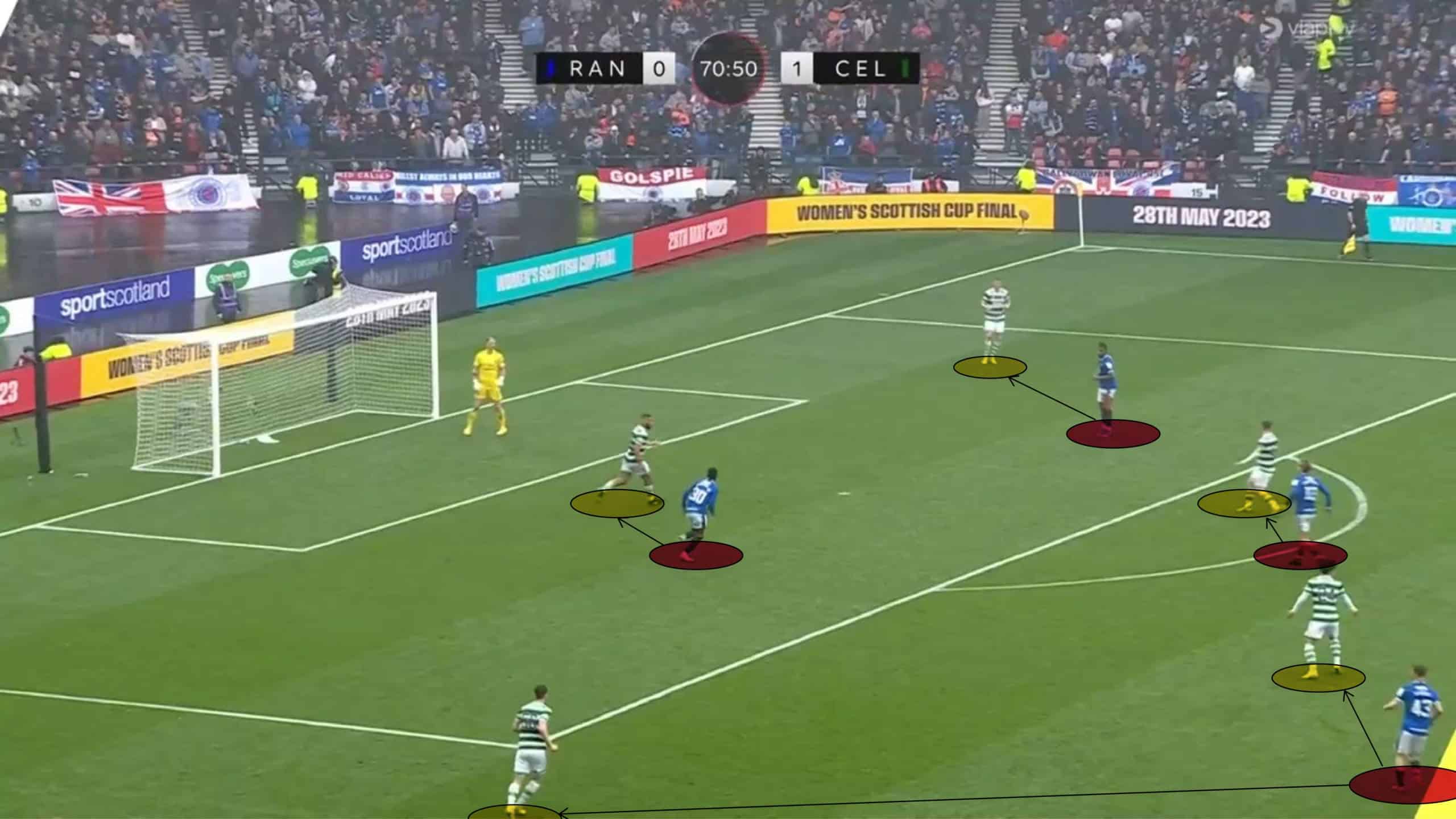
On the other hand, this strategy also exposed Rangers defensively, especially when Celtic could link up with the midfielders from the back.
However, thanks to Celtic’s quality of playing in short spaces, they were still capable of succeeding in the build-up. In the example below, we can see Lundstram man-marking Mooy and being attracted to the line. This action opened space for the other midfielder (Iwata) who received the ball with no opposition pressure and made a good pass in behind.
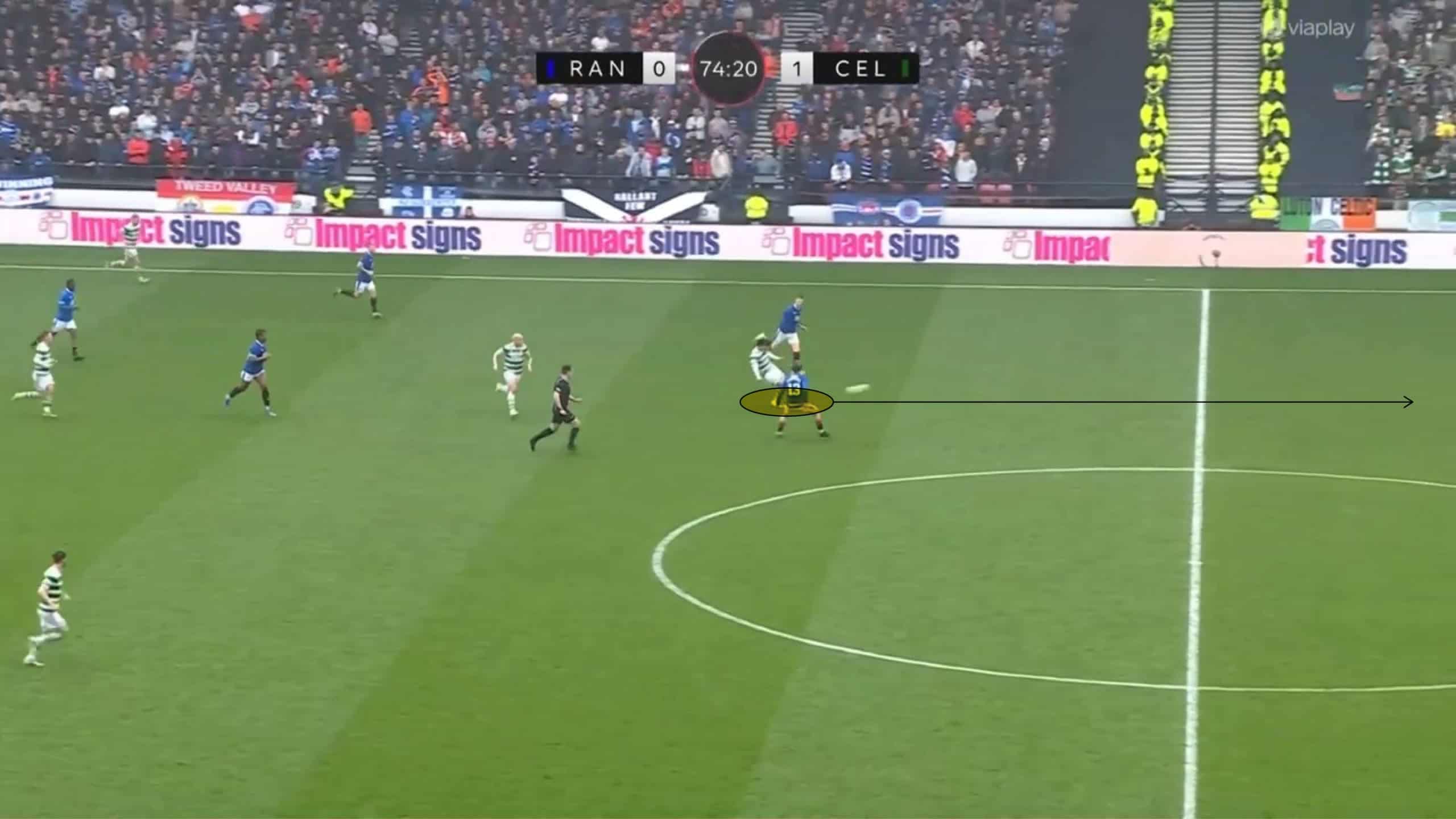
How some details can dictate a derby result
We also feel that is important to uncover some crucial details which lead to the only goal of the match. Firstly, the most obvious detail is related to the lack of aggression and intensity of the three players that were directly involved in the play, Raskin, Lundstram and Barisic.
The second detail has to do with Ryan Kent’s defensive transition, which was poor, forcing the defensive midfielder, in this case, Raskin, to mark the player on the flank. Furthermore, Ryan, who had a poor performance, also could have done better by covering up Raskin, closing the gap between them.
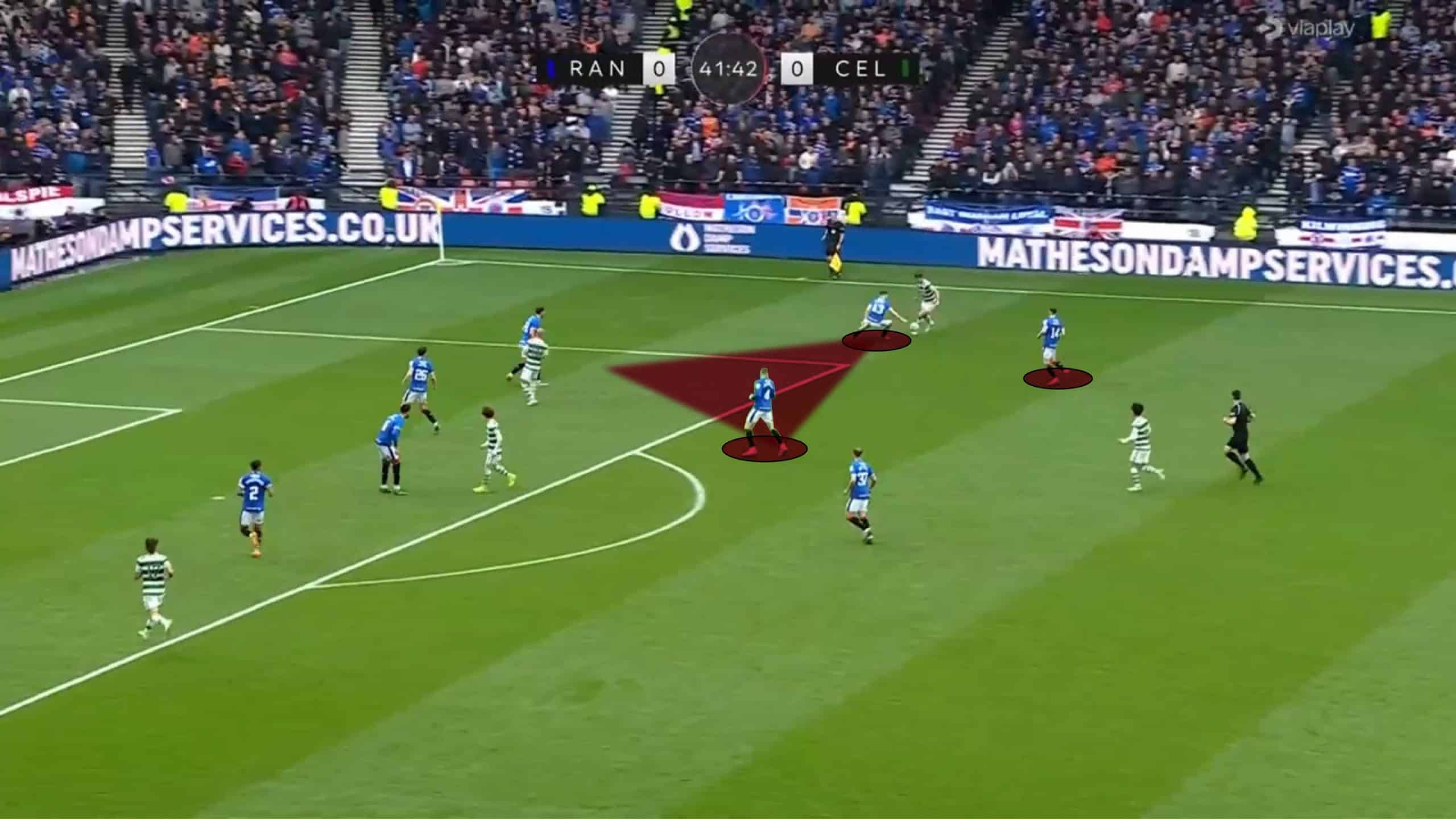
Finally, the last one is related to Tavernier’s body shape, where the right-back has both of his feet parallel and as it goes, he could not scan and see what was happening behind his back. If Tavernier had his body oriented on a diagonal, then he would be able to follow the ball and see Jota making that movement.
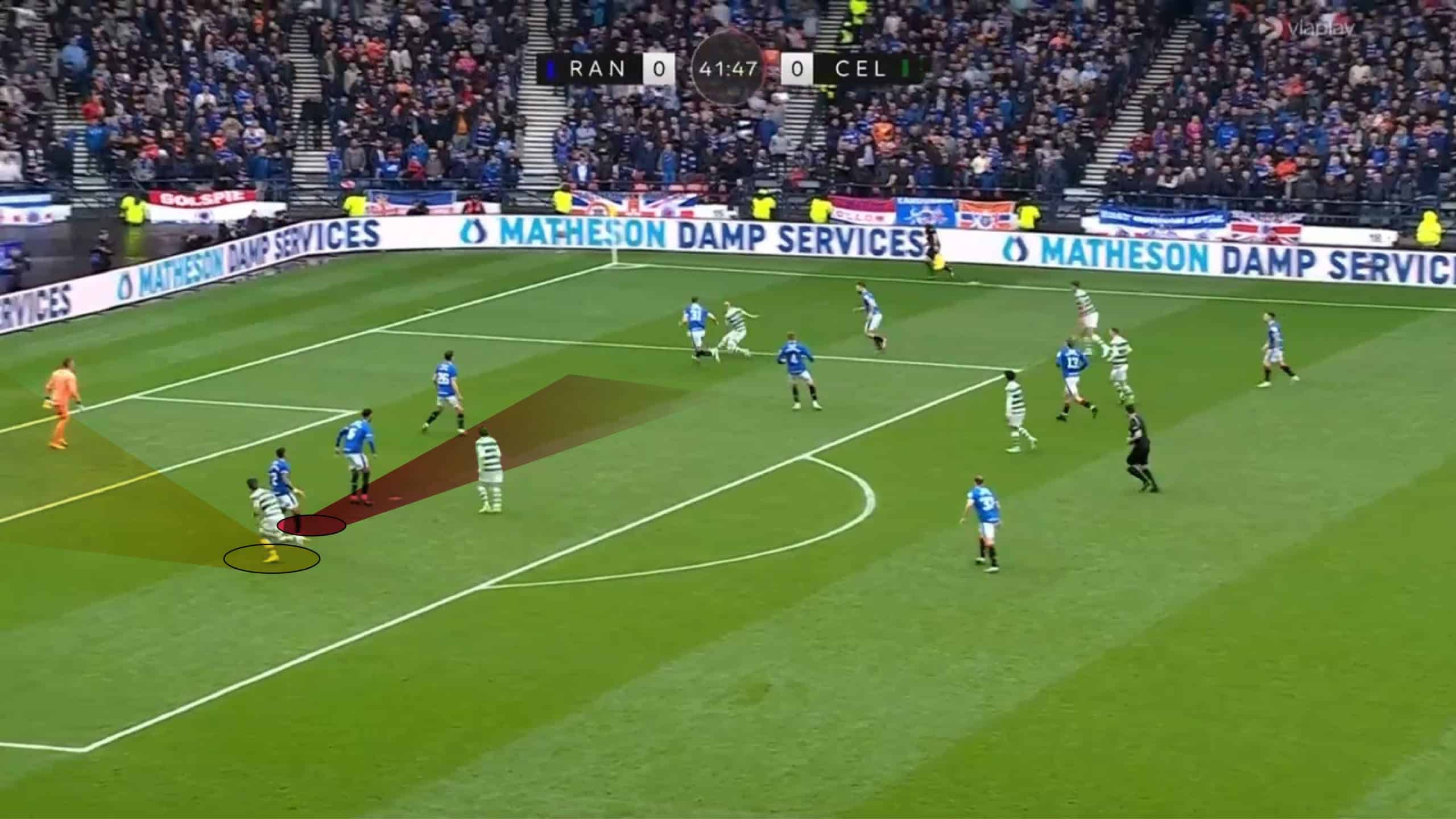
Conclusion
In general, it was a very intense and aggressive game in which Celtic were the team with more possession and that were able to arrive with more danger to the opposite goal.
As we mentioned above, this dominance took place, among other factors, due to the high-intensity pressing and the good mobility of their players, especially Hatate with positional freedom and Taylor as an inverted fullback.
However, in the second half, the game took a different course and Rangers intensified their pressing and became more successful in their build-up. The fullbacks, Tavernier in particular, gained confidence and were deeper on the pitch, supporting their team offensively.
At a top level, details make all the difference, and this game wasn’t an exception. Some distractions were enough to decide a game and in this case, those distractions were relative to Tavernier’s body shape and to other players’ lack of aggression.

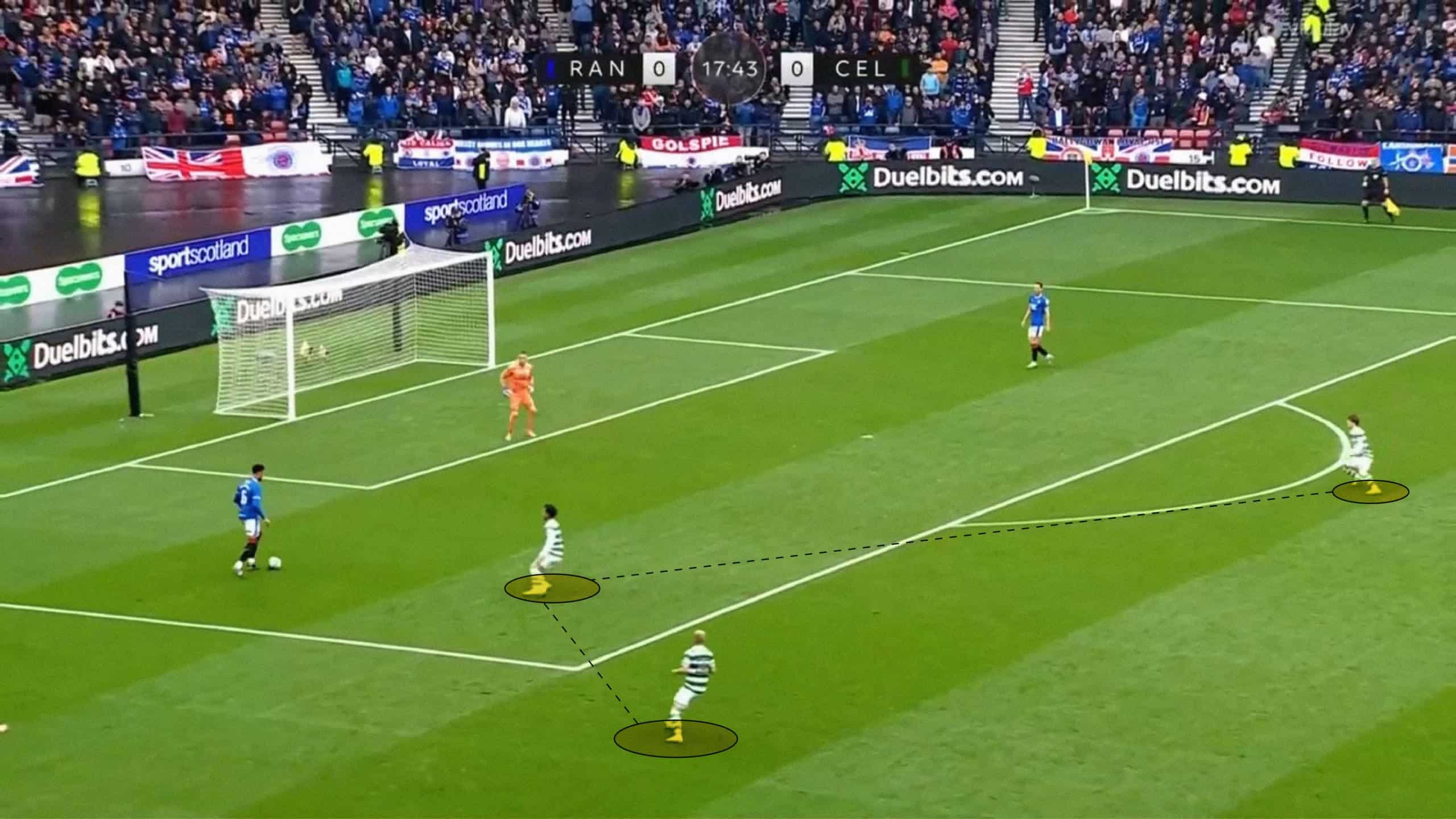




Comments